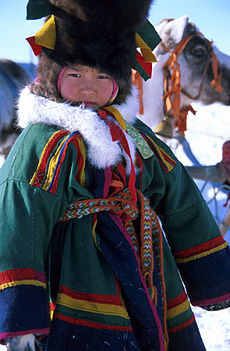Nenets people

Nenets child
|
|
| Total population | |
|---|---|
| (44,857 (2010 Census)) | |
| Regions with significant populations | |
| Russia | |
|
|
44,640 |
|
|
217 |
| Languages | |
| Nenets, Russian, Komi | |
| Religion | |
|
Shamanism, † Orthodox Christianity (Russian Orthodox Church) |
|
| Related ethnic groups | |
|
other Samoyedic peoples |
|
other Samoyedic peoples
Enets
Nganasans
The Nenets (Nenets: ненэй ненэче, nenəj nenəče, Russian: ненцы, nentsy), also known as Samoyeds, are an indigenous people in northern arctic Russia. According to the latest census in 2010, there are 44,857 Nenets in the Russian Federation, most of them living in the Yamalo-Nenets Autonomous Okrug and Nenets Autonomous Okrug. They speak either the Tundra or Forest varieties of Nenets.
9th century, they were called "Самоядь", "Самодь", (samoyad', samod', samodiytsy, samodiyskie narody) which was often transliterated into English as Samodi.
The literal morphs samo and yed in Russian convey the meaning "self-eater", which appears as derogatory. Therefore, the name Samoyed quickly went out of usage in the 20th century, and the people bear the name of Nenets, which means "man".
When reading old Russian documents, it is necessary to keep in mind that the term Samoyed was often applied indiscriminately to different peoples of Northern Russia who speak related Uralic languages: Nenets, Nganasans, Enets, Selkups (speakers of Samoyedic languages). Currently, the term "Samoyedic peoples" applies to the whole group of different peoples. It is the general term which includes the Nenets, Enets, Selkup, and Nganasan peoples.
...
Wikipedia
